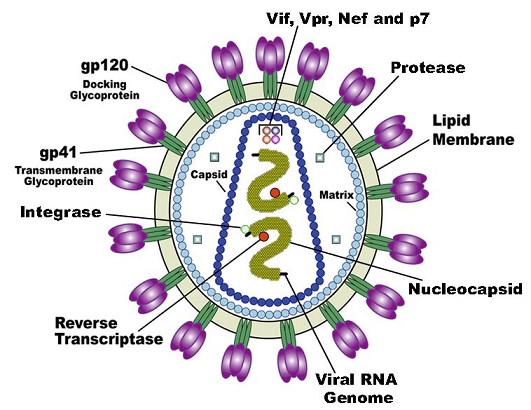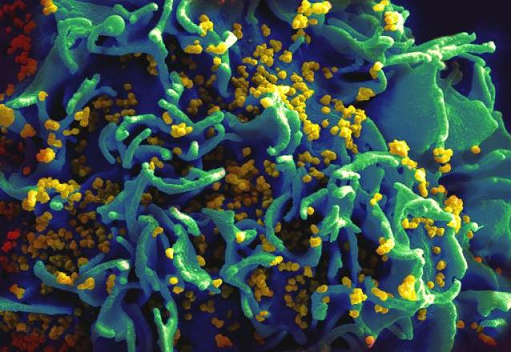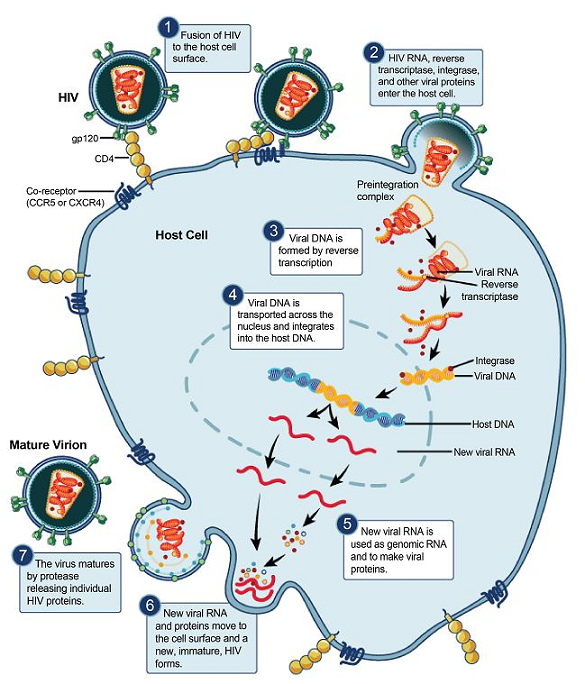|
|
|
Medical Pharmacology Chapter 36: Antiviral Drugs
Antiviral Drugs
Anti-viral drugs with activity against HIV (Human Immunodeficiency Virus)
Introduction: Human Retroviruses continued: Viral Replication
 |
|
The HIV replication cycle begins with the association of the viral gp120 protein with the host cell surface receptor, the CD4 molecule.2
|
|
|
 |
|
The CD4 protein is mainly associated with a T lymphocyte subset responsible for immunological helper function.
In addition to the T cell lymphocytes, CD4 molecules are also expressed on monocyte/macrophage and dendritic/Langerhans cell surfaces.
Following gp120 binding to CD4, a conformational change in gp120 facilitates additional association with one of two major co-receptors.2
![]() The two
major co-receptors for HIV-1 are CCR5 and
CXCR4.
The two
major co-receptors for HIV-1 are CCR5 and
CXCR4.
These receptors belong to the well-known seven-transmembrane-domain G protein-coupled cellular receptor family.
Furthermore, viral cellular tropism is determined to a significant extent by the viral use of one or the other or both co-receptors.
Some dendritic cells express various C-type lectin receptors on their surface.2
One such receptor, DC-SIGN, exhibits high affinity for the HIV gp120 envelope protein.
This association enhances HIV viral binding to the CD4+ T cell (following DC_SIGN interaction with dendritic cells).
After binding of the envelope protein to the CD4 molecule and subsequent viral envelope gp120 conformational change, host cell membrane-viral fusion proceeds, utilizing the newly exposed gp41 molecule.2
 |
|
The gp41 protein penetrates the target cell plasma membrane and undergoes a structural change that brings the virion and target cell in close approximation.
Following fusion, the preintegration complex, composed of viral DNA and viral enzyme, all surrounded by a capsid protein coat, is released into the target cell cytoplasm.
The preintegration complex translocates through the cytoplasm, reaching the nucleus and at that point the viral reverse transcriptase catalyzed reaction promotes transcription of genomic RNA into DNA with the protein coat opening and thus releasing the new double stranded proviral HIV-DNA.2
|
|
|
In this stage of replication cycle, the viral genome may be susceptible to cellular constituents which may block infection progression.2
 |
|
|
|
This Web-based pharmacology and disease-based integrated teaching site is based on reference materials, that are believed reliable and consistent with standards accepted at the time of development. Possibility of human error and on-going research and development in medical sciences do not allow assurance that the information contained herein is in every respect accurate or complete. Users should confirm the information contained herein with other sources. This site should only be considered as a teaching aid for undergraduate and graduate biomedical education and is intended only as a teaching site. Information contained here should not be used for patient management and should not be used as a substitute for consultation with practicing medical professionals. Users of this website should check the product information sheet included in the package of any drug they plan to administer to be certain that the information contained in this site is accurate and that changes have not been made in the recommended dose or in the contraindications for administration. Advertisements that appear on this site are not reviewed for content accuracy and it is the responsibility of users of this website to make individual assessments concerning this information. Medical or other information thus obtained should not be used as a substitute for consultation with practicing medical or scientific or other professionals. |